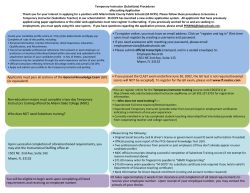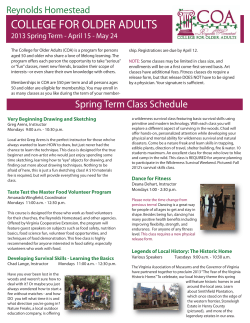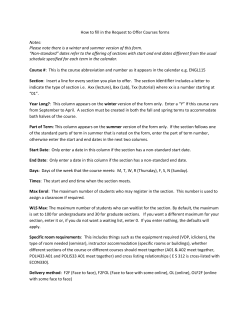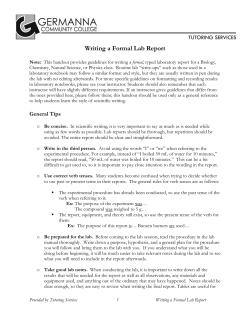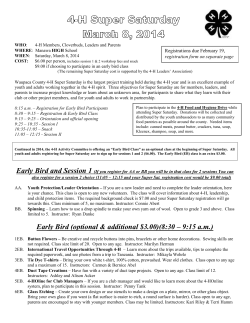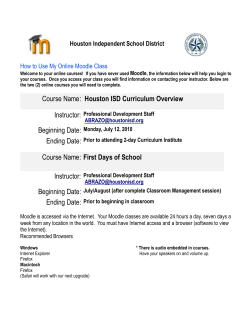
How to Prepare and Moderate Online Discussions for Online Learning 2013 www.contactnorth.ca www.contactnord.ca
How to Prepare and Moderate Online Discussions for Online Learning 2013 www.contactnorth.ca www.contactnord.ca It is often through online discussion that the highest quality of learning is developed in online courses. This is sometimes overlooked in the excitement of MOOCs, flipped classrooms, hybrid learning and other recent developments. There is substantial research to indicate that the quality of discussion can be as high, if not higher, online as in class, so long as ‘best practices’ are used. Many of the features that are true for developing good discussion in class are also true for online discussion, but there are also some special requirements for ensuring, not only that the quality of discussion is high, but that all, or nearly all, student are participating. Let’s explore these ‘best practices’. BE CLEAR ABOUT YOUR GOALS As with classroom discussion, it’s important to be clear about your goals. In most cases the educational goals for online learning are the same as in class, but in some ways discussion is even more important for online learners who otherwise are working in isolation, without regular contact with other students. Purposeful discussion is therefore helpful in getting online students engaged as learners, and feeling they are part of a learning community. The emphasis though is on purposeful discussion. There is a good deal of research evidence to show that students will not participate in online discussions if they feel the discussion forums are not directly helpful to their learning, and in particular if the discussion will not directly help them get better grades. We will return to this point later. There is a wide variety of possible goals for online learning discussions. We list just some below: • improved comprehension: to enable students to clarify their understanding of key concepts in the course through discussion with other students; • building an argument: analyze the logic or power of someone else’s argument and build and defend one’s own position, using materials from the course or other relevant materials; • knowledge construction: to encourage a deeper understanding of concepts, their applicability in different contexts and their relatedness to other concepts, or to acquire new meanings; • collaborative learning: to enable students to learn from each other, to share knowledge and experience, and to learn to support and help each other; • critical thinking: to encourage students to engage constructively in critical analysis of ideas, concepts, philosophies and processes/procedures, and to form, defend and reflect on their own position on issues raised in the teaching; • to create a learning community: to develop a sense of belonging to a group with similar learning interests, in order to foster student engagement, and improve student retention; 2 • feedback for the instructor: to enable the instructor to see how learning is taking place within the group, to identify misunderstandings or areas of weakness in the learning, and to provide an opportunity for additional teaching and support for the students as a group. Instructors should be clear in their own minds about the goals or purpose of group discussion and should also communicate that purpose clearly to the students in the course. It is also important for the instructor to design and facilitate discussions so that they facilitate the achievement of such goals, and this is where online learning differs somewhat from face-toface discussions. SYNCHRONOUS OR ASYNCHRONOUS? Classroom discussions are basically synchronous, in that all the students and instructor are online together and are in discussion at the same time. Synchronous discussions can also be held online, using tools such as Blackboard Collaborate or Centra, that allow the instructor to ‘moderate’ the discussion by controlling access to the microphone. Other tools include a ‘live chat’ facility that allows comments to be typed and read by the whole group in real time. Social media such as Twitter can also be used to encourage discussion in short bursts of 140 characters for instance during a lecture or other synchronous activity. Instructors vary in their preference for synchronous versus asynchronous discussion. For classroom instructors, it is easier to shift their classroom technique online with synchronous online discussions. However, most find that online synchronous discussions are less satisfying than a classroom discussion, because allowing ‘turns’ to speak is more clumsy online, and it is easier for students to ‘hide’ in an online discussion in real time, as there are no visual cues for the instructor. Thus synchronous online discussions often feel less spontaneous, although synchronous tools can be very useful for delivering lectures and handling questions and answers where students can take turns. Although online synchronous discussions allow students to participate from home or campus, they have to participate at fixed times that may not suit all students (although the sessions can be recorded and downloaded later). However, this usually means a fixed schedule (say once a week) for discussion - as with a classroom. Asynchronous discussions however are unique to online learning. Students can log in at any time and participate in an asynchronous discussion, although to encourage dialogue and argument, there are usually set start and end times for a discussion topic that may nevertheless sometimes spread over several weeks or in some cases a whole course. 3 There are also tools that help instructors organize and moderate asynchronous online discussions, such as discussion forums in a learning management system. A particularly important technique is to enable comments to be ‘threaded’. Instead of comments appearing in time order (the first comment shows up on the screen first, with the second comment showing second - called a ‘bulletin board’ approach), comments are linked to a specific earlier comment to which it is related. This allows for different topics, sub-topics and arguments to run in parallel, but with all the comments on a specific topic directly linked to one another. Threading comments encourages deeper and longer discussions that are easily tracked. If required, most learning management systems also provide spaces for ‘private’ discussions, where small student groups for instance can discuss a project design without the whole class being involved. These can be set up either to allow access to the instructor (recommended) or they can be open only to the students in the group. Thus for deeper levels of discussion, and greater flexibility for both learners and instructor, asynchronous discussion forums are often preferred. Some instructors who have experience with both classroom and online discussion forums actually prefer online discussion, not just because of its flexibility, but because it also gives students a chance to reflect or do research or further reading before responding. It can be seen that both approaches have strengths and weaknesses and both approaches can be combined, with each other or with classroom teaching. Figure 1 provides a summary. Figure 1: Differences between online synchronous and asynchronous discussion Synchronous Asynchronous Tools Collaborate; Centra, VIA, WebEx; Chat; Tweets Threaded discussion forums Similarity to classroom teaching More similar Less similar Spontaneity Thinking ‘on feet’ More reflective Pedagogical strengths Good for lectures, information transmission, Q&A Good for extended discussion, knowledge construction, organizing 4 discussion, developing academic discourse Flexibility for students More than classroom, less than asynchronous Very flexible Dominant communication One to many style Many to many Teacher to student ratio Better for smaller groups Better for larger groups HOW TO ORGANIZE YOUR DISCUSSION FORUM Merely putting students into an online laboratory or a forum for discussion does not necessarily lead to learning taking place. Indeed, discussion forums (whether face-to-face or online) can far too easily degenerate into a swapping of opinions between students, without any change in understanding, attitudes or knowledge. Thus the teacher’s role in moderating online discussions is critical. Special attention needs to be given to the organization of online discussions. Students need to know what is expected of them regarding participation in discussion forums. If students feel that this is optional or not necessary, many will not participate. Rather than making it mandatory by giving grades or marks for participation, it is much better to design the course so that discussions are seen by students to be helpful in furthering their learning and contributing to their assessment by enabling them to learn more through discussion. However, this requires both organization and skill on the part of the instructor. What is the optimum group size for an online discussion? This will depend on a number of factors, but some general guidelines can be given: • A teacher-student ratio of between 20-30 students is recommended, for both pedagogical and workload reasons. A minimum class size is needed to generate good discussion, especially as not all students will actively participate. Students do not all work at the same pace and so not all students are ready at the same time to participate in a particular topic. Students also need to develop experience and confidence to participate fully and well in online discussion forums. Freshmen tend to be more reticent; graduate students more confident. Thus for undergraduate teaching, ratios should tend towards the upper limit of 30 students per instructor, and for graduate teaching towards the lower figure of 20, to ensure enough quality contributions from students to develop a good discussion, without overloading the instructor. 5 • • • • a large class of 100 students or so should be broken up into about three to five sections, each with its own instructor/teaching assistant. With a class of 100, and only one instructor, the class could be divided into four groups of 25, with the instructor moving between the four group discussions, although this would mean a heavy workload for the instructor, or less active participation. a tenured or full-time faculty member should instruct or moderate at least one section of the course at a minimum, as well as being responsible for the initial course design and development. It is important for the senior instructor responsible for a course to get direct feedback from student performance on how well the course is working, and the discussion forums are a particularly useful source to indicate how students are approaching their learning. other types of instructor, such as an adjunct faculty member, or a teaching assistant can be hired to teach other sections, under the supervision of the senior instructor. (Because asynchronous online discussions are permanently recorded, they are easily accessible to the senior instructor and can be scanned quickly). small groups: students can be further sub-divided into smaller groups of around five for group project work, with their own private area of discussion in the online forum. HOW TO MANAGE AN ONLINE DISCUSSION There is now more than 20 years of research and experience in managing online discussions. . Here are just some of the lessons learned: 1. Set Clear Student Expectations. This has three components (the less experienced the students are in online discussion, the more detailed the guidance will need to be): • clear academic goals for the discussion forums, clearly communicated to students at the start and throughout the course; • practical guidance on how they are expected to participate: the nature of the comments (constructive, not personal, etc.), how often, and direct links to assessment questions. Examples of appropriate (and inappropriate) student comments from previous course discussions can be given at the start of the course; • code of conduct: most institutions have an appropriate use policy for all institutional online activities, but this is often either not read or understood fully by students. Thus usually additional guidance will need to be provided specific to a particular course. An example is given below: 6 ONLINE DISCUSSION GUIDELINES The on-line discussion groups are an essential part of the course. As this is a graduate-level course, we expect you to participate regularly by reading the discussions and contributing to them. You should check in to the discussions at least three times per week and contribute at least two messages to each discussion. We also expect you to follow up any responses to your contributions. You and other participants will be going off and searching out information, and these discussion groups provide you with an opportunity to share your knowledge, to seek feedback from fellow students as well as the instructor on your ideas, and to ask for help when you need it. The discussion topics are closely related to the assignments. The discussion topics are usually included in the relevant teaching materials as well as in the “Forums” section. You are expected to respond to the topic, issue or question with comments that are considered, and that reflect your personal opinions, experiences, and knowledge. Where appropriate, your comments should take into account the relevant course readings. Feel free to quote readings you feel might be of interest to others in your group. Try to remain focused on the topic. You are free to start your own topics, but if you do so, please do not post these as responses to the main topic. Instead, start a new thread by posting a message at the top level of the forum. If you don’t understand what this means or how to do this, please contact your instructor. Active participation in the discussion is expected and encouraged. Each post should: • • • • • add to the discussion; bring about a new way of looking at the issues being raised; recognize where appropriate earlier contributions from other students if possible, incorporate the readings or other academic sources (quoting small passages is acceptable - try to limit quotes to no more than three or four lines); Responses that say more than “…I agree with that...” or “…same for me...” are expected. from Bates and Poole, 2003 7 2. Choose Appropriate Topics for Discussion This is one of the most important aspects of designing an online discussion. The choice of topic needs considerable skill to generate the desired learning outcomes. Choice of topics should be related to the learning outcomes expected from discussion, and discussion topics will always generate more student participation if they are either linked to assessment or have strong intrinsic interest for the students. Topics can be generated by the instructor or by the students themselves. There are at least three types of topics: • • • assessment-based: for instance, a group of students can be given a problem to solve. The discussion forum records their discussion of the problem and the processes they use to solve it, and students are marked on both the outcome and the process of solving the problem. assignment-related: This kind of topic is, or could be, directly related to an assignment, but is not the assignment itself. Thus the topic may provide the opportunity for students to discuss aspects of an assignment or to complete part of an assignment. For instance, if the assignment requires students to work on a project, one discussion topic could be about the framework or outline of a project, or a discussion of other projects already completed, and why they were good or poor. If there are important concepts that need to be dealt with in an assignment, then students could be given a case or exercise and be asked to apply the concepts to the case or example. Thus, if students have been taught how to do a business plan, they might be asked to discuss the best way to do market research on a particular proposal, while the assignment requires a full business plan to be developed, incorporating market research. interest-based: This kind of topic is not directly related to the assignment or maybe even the course, but one that generates a lot of interest in students. For instance, microbiology students may want to discuss recent laws or guidelines regarding stem cell research or ethical issues in cloning, although these may not be the main topics of the course. Topics must be chosen and worded in such a way as to encourage discussion. Topics for instance that suggest there is a ‘right’ answer or ‘best’ way to do things, or merely require students to repeat materials in the course, are often ‘dead-enders’, in that once an appropriate response has been made by one or two students, there is little more to add. Controversy is always a good way to generate discussion. However with controversial topics students can easily get into swapping opinions, instead of basing their comments on principles or ideas laid out in the course or on evidence other than their own experience. It is the instructor’s role to make expectations clear and to challenge students to use evidence and course materials to justify their argument. 8 The best topics are ones that require students to do some work in order to participate. Wording such as: “In the course readings, the article by X indicates that Y tends to happen. However, how does this square with what Z says in her article?” forces students to the readings and an analysis of the concepts or phenomena being discussed. It requires the student to make some judgements and to think through their own answer, and also allows other students to disagree with or modify other students’ comments. Generally it is best to keep each topic broad and relatively open, allowing for a variety of different contributions. 3. Be an Active Moderator Harasim et al (1995) state this very clearly: “Though the teacher needs to be present, the network enables the teacher to play a facilitative, observant, but background role. The primary focus should be on the students’ own thinking processes and collaborative learning.’ (p. 174). A challenge for many instructors in online asynchronous discussions, when there may be several days between one student posting a comment and others responding, is to be patient and allow time for students to develop their own thoughts. Nevertheless, instructors must be active. If discussions drift off topic, they need to be re-focused by the instructor. Students often do not draw on the content of the course when posting comments, giving just an opinion on the topic. Students need to be challenged on this, and directed or asked to look up where necessary the relevant materials in the course, and to reconcile this with their own opinions. Where two or more students have different or conflicting opinions, they should be asked to identify or be directed to parts of the course that support - or even better - challenge their opinions. Students can of course legitimately disagree with ideas or concepts in the course, but they should be encouraged, not only to give reasons for disagreeing with these ideas, but also to reference course content properly in the discussion. The role of the instructor is to move students away from opinions based solely on personal experience to evidence-based thinking. 4. Encourage Student Participation Students will vary in their willingness to participate in online forums. There are many strategies for encouraging participation. Probably the most important is to ensure that the discussions are meaningful and have significance for the students. Thus choice of topic and its relationship to assignments as discussed above will encourage many students to participate without further motivation. Here are some other ideas: 9 Set a Positive Tone All students should be encouraged to believe that they have a useful contribution to make to the discussion. The instructor needs to create an online environment that encourages participation, that encourages students to discuss with each other as well as the instructor, and encourages students to ask questions, risk judgements and opinions, and to help each other. Thus directly negative criticism of individual students’ comments, either by the instructor or by other students, should be discouraged or avoided if possible. Students and instructors should look for value in each contribution, even if it seems a dumb remark on first sight. Such comments can be turned to advantage by drawing on evidence to challenge the statement, or by exploring the underlying logic (or lack of it) behind the statement. If a student responds aggressively or dismissively to another student’s comments, the instructor needs to react quickly, by modeling an appropriate response, and recognizing the value of the both students’ comments. (‘I’m glad that X raised an interesting point, which is quite a common view on this topic. However, Y‘s response is also interesting, because..... What do the rest of you think?’ Instructors do need to intervene actively and take responsibility for moving the students away from easy answers that do not address the topic in any depth. At the same time the instructor should avoid doing all the thinking for the students. Students quickly learn what is expected, if the instructor intervenes early and quickly. This can save work and problems later in the course or program. Assign a Task Another strategy that is generally effective in getting even shy students to participate is to give them a task. Thus for instance, three students may be asked to work together to choose a topic for discussion, and give their reasons for choosing this topic as a posting in the discussion forum. They can be encouraged to work together via e-mail before making the posting. A deadline for completing the task is important. From there, other groupings of students can be organized, to ensure that every student in the section makes a contribution. For instance another three students could be asked to make the first response, and another three students could be asked to critique the response of the previous three students. The discussion could then be thrown open to all students in the section for individual comments. Lastly, three more students could be asked to summarize the discussion. This works well with students who are new to online learning, or in situations where many students are not otherwise participating. 10 Support Students Who Are Struggling Online teachers should watch out for individuals who do not appear to be participating. After the first week, an instructor should check on those who have not joined the conference. A private e-mail can be sent. If students post bios, an instructor can ask a non-participating student by private e-mail to respond to a particular comment, drawing on their unique experience. If the student lacks confidence, an instructor could ask the student to draft a response, and send it to the instructor as an e-mail for feedback before posting. Non-participating students can also be asked to join a group for a shared task, but care needs to be taken in doing this. Some students do not participate in online discussions for good reasons, such as a family crisis or overwork, and foisting them on other students is unfair to all. Thus if a student is not participating, it is generally best for the instructor to identify the reason before taking remedial action. Address Aggressive Participants Students who dominate discussion forums are the opposite problem. Such students will write long responses or will respond to every other students’ comments. They may also post aggressive, critical or dismissive comments about other students’ contributions. Such students can cause a discussion forum to collapse very quickly. Nevertheless these students in fact can be a great resource, as they are often bright and have useful contributions to make. The aim then is to keep them active but in a controlled and disciplined manner. Again, the instructor’s strategy should start with private e-mails, thanking the student for their contribution, but suggesting that the student limit their postings to 250 words maximum. It could be suggested that in this way the student will be more focused and therefore more persuasive in their comments, as other students are unlikely to read long comments. Another strategy is in the next forum to ask the student to play the role of topic instigator and/or summarizer, and stay out of the general discussion so that their contribution can be ‘objective and more meaningful to the group as a whole.’ Consider Cultural and Language Factors There are sometimes major cultural differences in students with regard to participating in online discussion forums. These reflect deep differences with regard to traditions of learning and teaching. Instructors need to be aware of possible cultural differences when designing and moderating online discussions. For instance, students from overseas may come from a country where there is a strong tradition of the authoritarian role of the teacher and the transmission of information from the teacher to the student. In some cultures, it is considered disrepectful to challenge or criticize the views of teachers or even other students. In an authoritarian, teacher-based culture, the views of other students may be considered irrelevant or unimportant. Other cultures may have a strong oral tradition, or one based on story-telling, rather than on direct instruction. 11 Lastly, of course, there is the challenge of students for whom English is a second language, where the course or program is offered in English. It can be argued that students working in a second language are at less of a disadvantage in an online discussion forum than in a faceto-face class. In an online forum, they have time to reflect and compose a response. Students working in a second language can be helped and encouraged in online courses. They can be assured that it is better to participate, even if their English or the main language of the program is not perfect, than not to participate at all. It is possible to distinguish between thoughtful contributions that show understanding of the course materials and original and creative thinking (even though the English may not be perfect), from comments where the English is perfect, but the comment is poor in terms of structure or meeting the course objectives. Nevertheless, the expectations with regard to the working language of the course need to be clearly stated before students enroll in an online course, and clear statements of learning outcomes can enable instructors to discriminate between good and poor assignments, irrespective of language difficulties. Thus instructors need to be aware that there are likely to be students in any class who may be struggling with language, cultural or epistemological issues. For a fuller discussion of this, see the journal Distance Education, Vol. 22, No. 1 (2001). The whole edition is devoted to papers on this topic. TO GRADE OR NOT TO GRADE ONLINE CONTRIBUTIONS Should students be graded for their participation in online discussion forums? As always, this will depend to some extent on the students, the desired learning outcomes, and the instructor’s teaching philosophy. If you believe that students only do what gives them immediate gratification, this is one reason for grading participation. If students are ‘surface’ rather than deep processors, or highly instrumental in that they only do the minimum work necessary to get a pass grade, then some form of grading of their online activities may be necessary. If the main goals of the course are to teach students online participation skills, collaborative learning skills, or academic discourse, then again there may be a justification for grading participation. However, in general it’s best not to grade students directly on their online contributions. One very pragmatic reason is that grading each student’s contribution to online discussion is extremely time-consuming, if it is to be done properly and fairly. Secondly, grading contributions tends to distort the nature of the discussion. Students tend to post statements to gain marks, directing them primarily at the instructor, rather than engaging in discussion with other students (other than to sometimes trash their comments). This also can lead to work overload for the instructor, if all students start posting long responses in order to get a high grade for participation. 12 Perhaps most importantly, it should be recognized that students learn in different ways. Some students will be happier ‘lurking’, i.e. reading some or all of the comments, rather than actively posting their own comments. Some will prefer to concentrate on the readings, while others will want to devote more time to preparing assignments. The discussion forums in most cases are a means to an end - better learning and thinking - than an end in themselves. They should have intrinsic value, being of interest and help to students in meeting the overall course objectives or learning outcomes. Thus it is better to focus the grading on the desired learning outcomes for the course, recognizing that individual students will choose different routes to get to those outcomes. Thus tests, essays, or projects may be better means to assess students in the long run, than measuring their contribution to the forums. Instructors can also use their discretion and take into account when marking essay-type assignments a student’s contribution to the online discussion forums. In summary, with proper design and preparation, online discussion can be as rewarding and as intellectually exciting as any classroom-based discussion group, but as in both forms of teaching, it requires patience, skill and good communication with students. Suggested further reading Bates, A. and Poole, G. (2003) ‘Chapter 9: Supporting Technology-Based Learning’ in Effective Teaching with Technology in Higher Education San Francisco: Jossey-Bass/John Wiley. Much of the above was developed from this chapter. The book also discusses different teaching philosophies and course design and development. Harasim, L. (2012) Learning Theory and Online Technologies New York/London: Routledge An excellent recent book which provides both theory and practical suggestions about teaching online, and is particularly strong on using online discussion for knowledge construction. Jonassen, D., Davidson, M., Collins, M., Campbell, J. and Haag, B. (1995) ‘Constructivism and Computer-mediated Communication in Distance Education’, American Journal of Distance Education, Vol. 9, No. 2, pp 7-26. A very good introduction to a constructivist approach to teaching online. Paloff, R. and Pratt, K. (2007) Building Online Learning Communities San Francisco: John Wiley and Co. Salmon, G. (2000) E-moderating London/New York: Routledge ©© Contact North | Contact Nord 2013 13
© Copyright 2025
